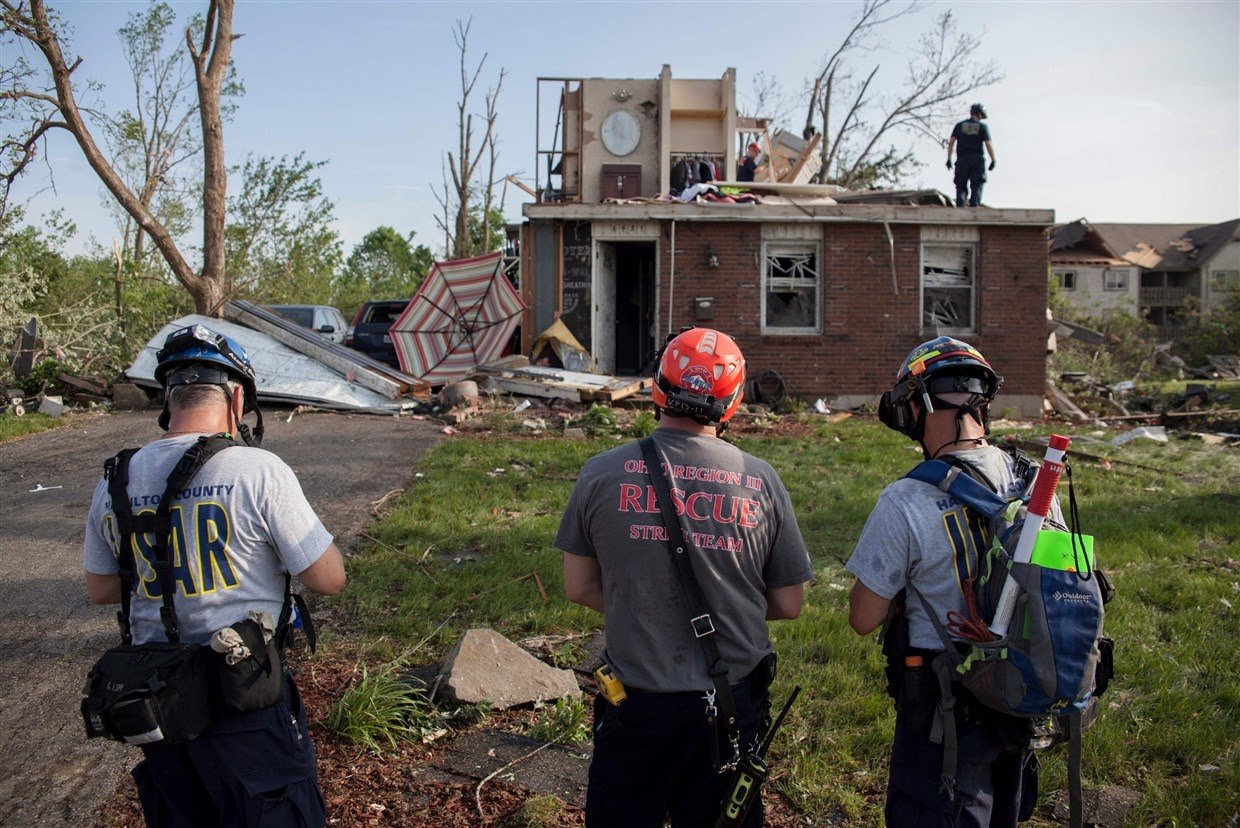Scientists say the number of tornadoes per outbreak is increasing, but explaining this uptick has been challenging.
Members of a search-and-rescue team inspect homes in Trotwood, Ohio, on May 28, 2019, after powerful tornadoes ripped through the that hit western Ohio late Monday marked the 12th consecutive day of such severe storms in the United States, with an average of 27.5 tornadoes occurring each day over that time period. If that seems like a lot, that’s because it is.
Scientists have found that since the 1950s, the annual number of tornado outbreaks has remained roughly the same, but the number of tornadoes per outbreak — or the number of days with multiple tornadoes — is increasing.
James Elsner, an atmospheric scientist at Florida State University in Tallahassee, said that on average, four to five tornadoes typically strike as part of a cluster. But he and his colleagues found that since 1950, the number of days with a cluster of at least 32 tornadoes has more than doubled, while smaller clusters have declined.
“The overall trend is not upwards, but what was surprising and sharply up is the fact that when conditions become favorable for tornadoes, we’re seeing more tornadoes per outbreak,” Elsner, who was the lead author of a 2014 study about this phenomenon, said.
Elsner added that the average number of tornadoes over the past 12 days is double the long-term average of tornadoes per outbreak.
But figuring out what is driving this uptick has been challenging.
“We’re not 100 percent sure what’s causing that,” said Victor Gensini, a climatologist at Northern Illinois University in DeKalb, Illinois. “There are theories that for any given outbreak, there’s more instability or fuel available for storms, but it’s really difficult to know.”
Part of the problem is that there is a lot of variability from year to year. Last year was a very quiet year for tornadoes, becoming the first year since modern record-keeping began in 1950 that there were no “violent” tornadoes in the U.S. Violent tornadoes are those with estimated wind speeds of 166 miles per hour or higher.
This year is already shaping up to be more destructive. So far in 2019, there have been 935 reported tornadoes across the country, according to the National Oceanic and Atmospheric Administration. This is up from an average of 743 tornadoes at this point in the year from 2005 to 2015, Gensini said. Monday’s rash of tornadoes, which caused widespread damage in the Dayton, Ohio, area and knocked out power to around 68,000 households, already ranks as the fourth most active tornado day of 2019, according to NOAA statistics.
Another issue is that scientists need more data. The most detailed records of tornadoes only extend back to the 1950s, making for a relatively short history of how things have changed, Gensini said.
This limited historical record also makes it difficult for researchers to know precisely what — if any — impact climate change is having on the frequency and severity of tornadoes.
There are two main ingredients that help tornadoes form: atmospheric instability, typically from a buildup of moisture and heat in the atmosphere, and wind shear, which refers to changing wind speed and direction with height that lifts air up and contributes to the storm’s violent rotation.
Climate change is causing ocean temperatures and global surface temperatures to increase, which in turn drives atmospheric instability when warm, moist air moves across the middle of the country, according to Kevin Trenberth, a senior scientist at the National Center for Atmospheric Research in Boulder, Colorado.
“All of this provides more fuel for thunderstorms and sets the stage for tornadoes to develop,” Trenberth said.
But while scientists also predict that wind shear may decrease as the Arctic warms, climate models show that atmospheric instability from climate change will probably contribute to more tornadoes overall.
“If you don’t have a cold Arctic, it’s hard to get a really strong wind shear across the Pacific Ocean,” Gensini said. “It’ll be a bit of a struggle between these two blocking weather patterns, but our climate models show that instability wins out, which suggests that we’ll see more tornadoes.”
Gensini said it is difficult to know the impact that climate change is having on specific extreme weather events, or in particular regions of the country, but that general trends are consistent with models that incorporate the planet’s changing climate.
“The analogy I like to use is with baseball’s steroid era,” Gensini said. “It’s a very difficult question to answer if this one home run was caused by steroids, but when you look at the batting average or the number of home runs over that time period, it’s easy to say that, yes, statistically a lot of those home runs were likely caused by steroids.”
Want more stories about the environment?1 million species under threat of extinction because of humans, new report findsYour clothes are secretly polluting the environment. Here’s why you should be concerned.This floating city concept is one way to cope with climate change

COMMENTS